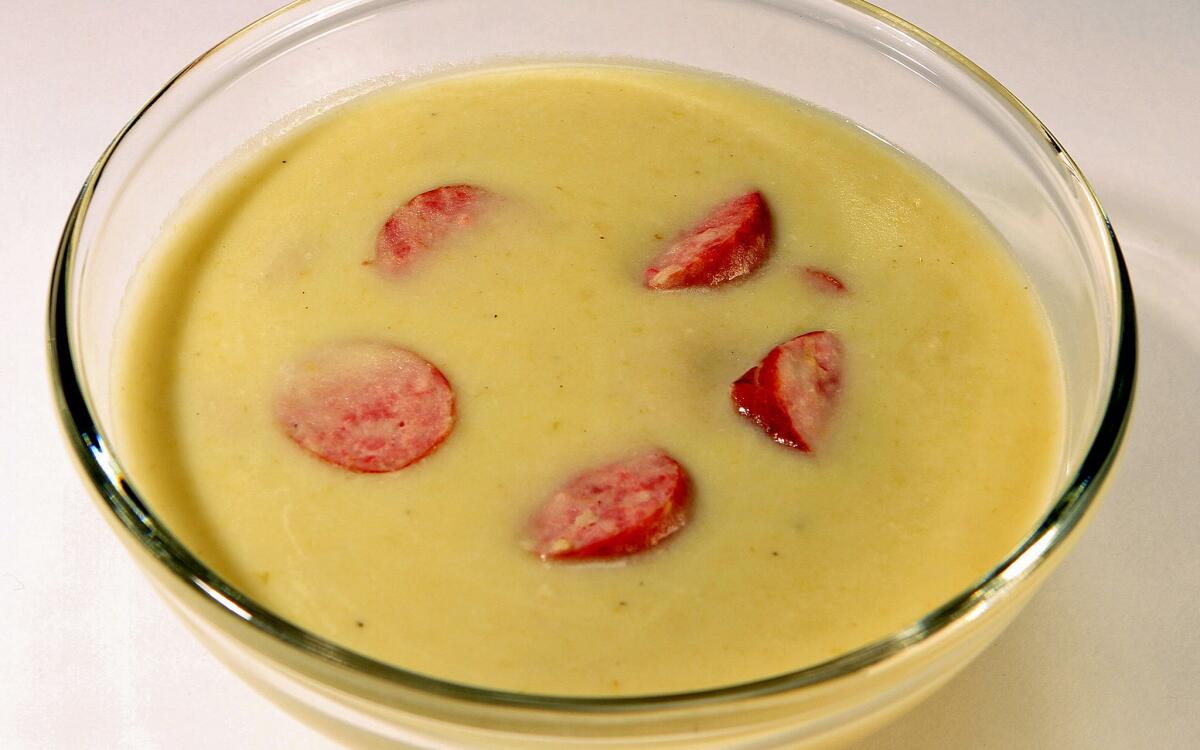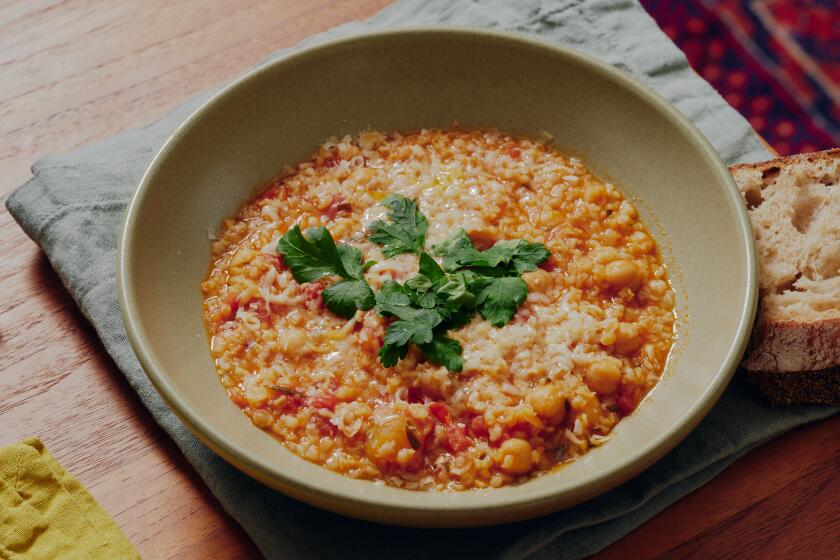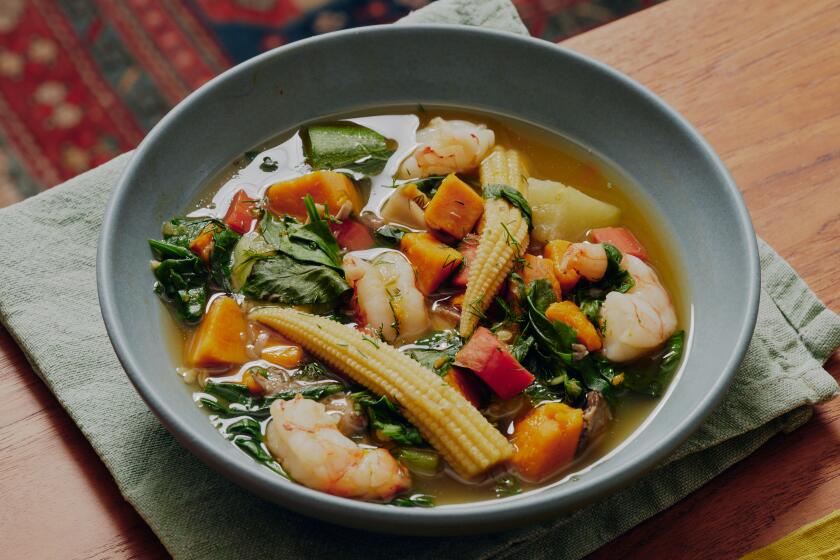Polish white borscht

My paternal bloodline brims with soup: barley stews studded with black mushrooms and opaque as porridge; the thin tomato broth of our Polish Christmas Eve vigil, swimming with dumplings no bigger than a bird’s eye; and the plain, milky, peasant concoction, assembled from Grandma Sophie’s kitchen scraps, known affectionately within the clan as “dough-ball-soup.”
Though my grandmother is gone and her soups have not passed my father’s lips in nearly 20 years, come winter, like clockwork, he sighs for them. So my mother and I do what we can -- what Karnasiewicz women have surely been doing for generations: We chop and shred and fill our stockpots. We comfort each other with borscht.
Indeed, of all our soups, this is my family’s edible valentine: the steaming bowl of claret-colored stock streaked with cabbage and turnip and faintly perfumed with vinegar and clove; tender strands of simmered beef, as dark and as soft as pumpernickel; a filigree of fresh dill and a scoop of sour cream that melts into a pastel smear; and horseradish to heat up everything.
Borscht. No, it does not sound beautiful. But when well made, few dishes can be as seductive. Clean and earthy and economical, a bit sour and a bit sweet, assembled from the humblest provisions and better with age, it’s a crimson silk purse stitched from a beetroot.
Traditionally, the borscht heartland has run in a wide river across Scandinavia, Eastern Europe and the Balkans, dribbling from Vilnius to Tbilisi, the Baltic to the Black Sea. But ultimately, cravings for borscht persist anywhere during dark, wet winter weather, when a bit of lightness and color is truly a gift.
Maybe you don’t have borscht in your bloodline? No matter: Despite what zealous Muscovites or Poles may argue, there are no “right” recipes -- nationalistic preferences and peccadilloes, regional flights-of-fancy and seasonal riffs, certainly -- but still borscht remains a dish largely defined by the way it has been adopted, and like minestrone, is an evolving and improvised affair.
There should be beets, yes -- for a bump of sugar and the signature ruby hue. (Although, in an exception to the rule, bialy barszcz -- Polish “white borscht” -- is beet-less, and it is divine.) Otherwise, borscht may contain as many as 20 ingredients or as few as four; be vegetarian or bulging with beef; be enriched with tomatoes, bulked out with beans, peppered by white cabbage or red, slurped hot or cold. (The quintessential everyman’s supper was designed to be forgiving, accepting of whatever the cellar contained.) In Ukraine -- where most sources agree it was introduced in the 1300s, and until recently might be found on a family’s breakfast, lunch and dinner table -- proverbs refer to it simply as “the center of everything.”
The borscht my father grew up on followed the Ukrainian tradition, meaning it was chockablock and meaty, built on a foundation of salt pork or short ribs, the meat left to slide from the bone, and the stock fortified with carrots, celery, onion, pepper and bay leaf. Then came the cornucopia: maybe a turnip or two, a russet potato, another carrot, a firm head of cabbage and a few petite beets, all carefully cubed and shredded and added with precise orchestration to achieve an equilibrium of silkiness and crunch.
Even now, standing over my stove, this is usually the template with which I start -- though, as with all headstrong children, the temptation to put my stamp on things invariably leads to digressions from the family line.
For instance: My husband isn’t a fan of celery, so goodbye to that; leeks and a fragrant fistful of garlic take its place. Sometimes my mood demands a meatless and more austere mushroom-based version. Sometimes I bulk up my bouquet garni with peppercorns, star anise and spiky cloves, which lends the pot the subtle scent of the Silk Road; or swap a russet for a sweet potato; or toss in that green apple, alone in the fruit bowl.
One of the hallmarks of borscht is its careful balance of sweetness and acidity. The latter element may come courtesy of lemon juice or vinegar or sauerkraut stirred into the stock, though traditionally, the source would have been kvass -- a beer-ish, fermented tonic made from rye, barley or sometimes beets themselves -- which has an ancient lineage among Slavic people, and remains ubiquitous throughout much of Russia. If you’re the DIY type, kvass isn’t terribly hard to make, and recipes abound on the Internet -- but in a pinch, most Central and Eastern European markets carry a commercial version that’s a fine substitute.
Or, you might do as I did recently, and let color inspire innovation. Meandering through the aisles of the market, my eyes fell on a pint of fresh cranberries. Their hue was a natural match for borscht, of course -- and also, I guessed, might be their tart juiciness. At home, I tossed the cranberries with sugar and salt, garlic, a glug of oil and a shower of fresh rosemary, spread them on a baking sheet and roasted them until their taut skins split. Then, into the pot they went to join with the pile of potatoes, carrots and onions already softening in bacon drippings. Finished with a few cups of chicken stock and left to simmer, the result was a beautiful new borscht base: sweet, sour and utterly surprising.
A teeming bowl of borscht is usually hearty enough to staunch all but the fiercest appetites, but a buttered bit of dense black bread on the side is an easy and invariably welcome addition to sop up the last few spoonfuls. If you’re after a more proper supper, though, you might take a cue from the Russians and offer a plate of savory filo pies; or the Poles, who prefer pierogi; or the Ukranians, who sprinkle galushki, dainty buckwheat dumplings, directly into the pot.
Then, finally, all that’s left to do is admire it. Ladle your borscht into a white bowl and gild it with a smudge of sour cream. Offer it to someone you love. Listen, and you may hear them sigh. They are satisfied. Your work is done.
Into a 4-quart heavy-bottom pot, place the kielbasa and the eggs (still in their shells). Add the water and bring to a boil over high heat. Reduce the heat, cover the pot and simmer gently for 8 minutes. Using a slotted spoon, transfer the hard-boiled eggs to a bowl of ice water to chill. Continue to simmer the kielbasa for another 15 minutes, then remove from heat. Drain the kielbasa, saving the cooking water and kielbasa separately.
Return the pot to the stove and melt the butter over medium heat. Stir in the garlic and leeks and cook until the leeks are softened, about 5 minutes. Reduce the heat and continue to cook until the leeks are very tender, about 20 minutes, being careful that the leeks do not brown or char as this will muddy the pale color of the soup. Stir in the potatoes and cooking water, then increase the heat to a gentle simmer. Cover and continue to gently simmer until the potatoes are tender, 25 to 30 minutes.
Using an immersion blender, or in batches using a stand blender, puree the leek and potato mixture until nearly smooth. Heat the soup over medium-low heat.
In a large cup or small bowl, whisk together the flour and sour cream to form a slurry. Stir one-half cup of the soup into the slurry to temper it, then whisk the slurry into the soup until thoroughly incorporated.
Slice the cooked kielbasa into one-half inch slices, and stir them into the soup. Stir in the horseradish, and season to taste with salt and pepper. The soup should have the consistency of heavy cream; adjust the consistency as desired with additional water.
Peel and roughly chop the hardboiled egg. Ladle and serve the soup in bowls, garnished generously with hardboiled eggs.
Get our Cooking newsletter.
Your roundup of inspiring recipes and kitchen tricks.
You may occasionally receive promotional content from the Los Angeles Times.















